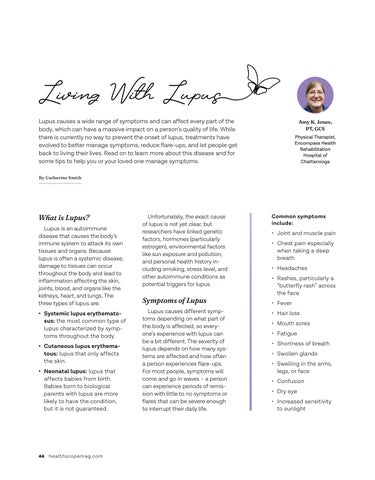Lupus causes a wide range of symptoms and can affect every part of the body, which can have a massive impact on a person’s quality of life. While there is currently no way to prevent the onset of lupus, treatments have evolved to better manage symptoms, reduce flare-ups, and let people get back to living their lives. Read on to learn more about this disease and for some tips to help you or your loved one manage symptoms.
Amy K. Jones, PT, GCS Physical Therapist, Encompass Health Rehabilitation Hospital of Chattanooga
By Catherine Smith
What is Lupus? Lupus is an autoimmune disease that causes the body’s immune system to attack its own tissues and organs. Because lupus is often a systemic disease, damage to tissues can occur throughout the body and lead to inflammation affecting the skin, joints, blood, and organs like the kidneys, heart, and lungs. The three types of lupus are: • Systemic lupus erythematosus: the most common type of lupus characterized by symptoms throughout the body. • Cutaneous lupus erythematous: lupus that only affects the skin. • Neonatal lupus: lupus that affects babies from birth. Babies born to biological parents with lupus are more likely to have the condition, but it is not guaranteed.
44
healthscopemag.com
Unfortunately, the exact cause of lupus is not yet clear, but researchers have linked genetic factors, hormones (particularly estrogen), environmental factors like sun exposure and pollution, and personal health history including smoking, stress level, and other autoimmune conditions as potential triggers for lupus.
Symptoms of Lupus Lupus causes different symptoms depending on what part of the body is affected, so everyone’s experience with lupus can be a bit different. The severity of lupus depends on how many systems are affected and how often a person experiences flare-ups. For most people, symptoms will come and go in waves – a person can experience periods of remission with little to no symptoms or flares that can be severe enough to interrupt their daily life.
Common symptoms include:
• Joint and muscle pain • Chest pain especially when taking a deep breath • Headaches • Rashes, particularly a “butterfly rash” across the face • Fever • Hair loss • Mouth sores • Fatigue • Shortness of breath • Swollen glands • Swelling in the arms, legs, or face • Confusion • Dry eye • Increased sensitivity to sunlight




